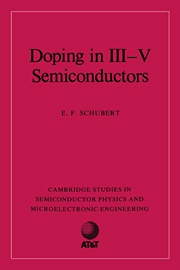Book contents
- Frontmatter
- Contents
- Foreword
- Preface
- List of symbols
- Introduction
- 1 Shallow impurities
- 2 Phenomenology of deep levels
- 3 Semiconductor statistics
- 4 Growth technologies
- 5 Doping with elemental sources
- 6 Gaseous doping sources
- 7 Impurity characteristics
- 8 Redistribution of impurities
- 9 Deep centers
- 10 Doping in heterostructures, quantum wells, and superlattices
- 11 Delta doping
- 12 Characterization techniques
- Appendix A Properties of III–V semiconductors
- Appendix B Constants and conversions
- References
- Index
Preface
Published online by Cambridge University Press: 05 October 2010
- Frontmatter
- Contents
- Foreword
- Preface
- List of symbols
- Introduction
- 1 Shallow impurities
- 2 Phenomenology of deep levels
- 3 Semiconductor statistics
- 4 Growth technologies
- 5 Doping with elemental sources
- 6 Gaseous doping sources
- 7 Impurity characteristics
- 8 Redistribution of impurities
- 9 Deep centers
- 10 Doping in heterostructures, quantum wells, and superlattices
- 11 Delta doping
- 12 Characterization techniques
- Appendix A Properties of III–V semiconductors
- Appendix B Constants and conversions
- References
- Index
Summary
It was realized in the infancy of semiconductor science that impurities are the essential ingredient in these materials. The first usage of the term ‘impurities’ dates back to 1931 (Wilson, 1931):
Electrons on a foreign atom [in a semiconductor] do not take part directly in [electrical] conduction. They must be transferred by the effect of lattice vibrations to an atom of the pure substance. In this case, the main function of the ‘impurities’ is to provide electrons for the upper unoccupied energy bands of the crystal, while acting as scatterers is only a secondary function.
The knowledge of the significant consequences of impurities motivated researchers to, first, purify the semiconductor materials, for example by zone refining, and, second, deliberately add ‘foreign atoms’ to purified semiconductors, for example by thermal diffusion of such ‘foreign atoms’ into the semiconductor. The deliberate doping of semiconductors with impurities required that the usage of the term ‘impurities’ was broadened. Such an extended definition was offered by Shockley (1950):
The conductivity arises from the presence of [] atoms which are termed ‘impurities’, even though added to the otherwise pure [] [semiconductor].
The term ‘dopant’ was non-existent in the English language until its introduction in 1963 by Seidman and Marshall (1963), who wrote about crystal growth from the melt:
The melt consists of intrinsic polycrystalline Ge and Si mixed with suitable ‘dopants’ such as P, which produces an n-type melt, or Ga, which produces a p-type melt.
- Type
- Chapter
- Information
- Doping in III-V Semiconductors , pp. xv - xviiPublisher: Cambridge University PressPrint publication year: 1993

